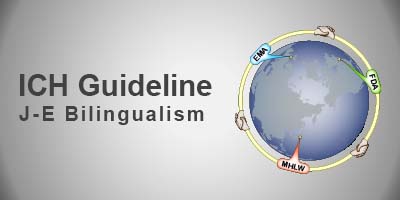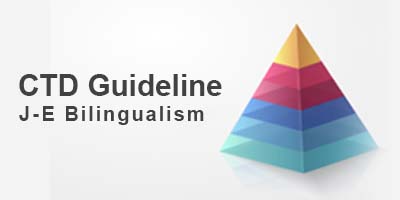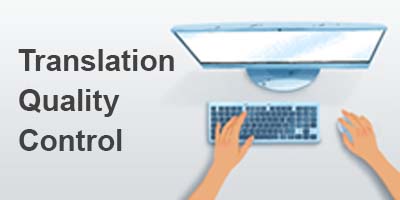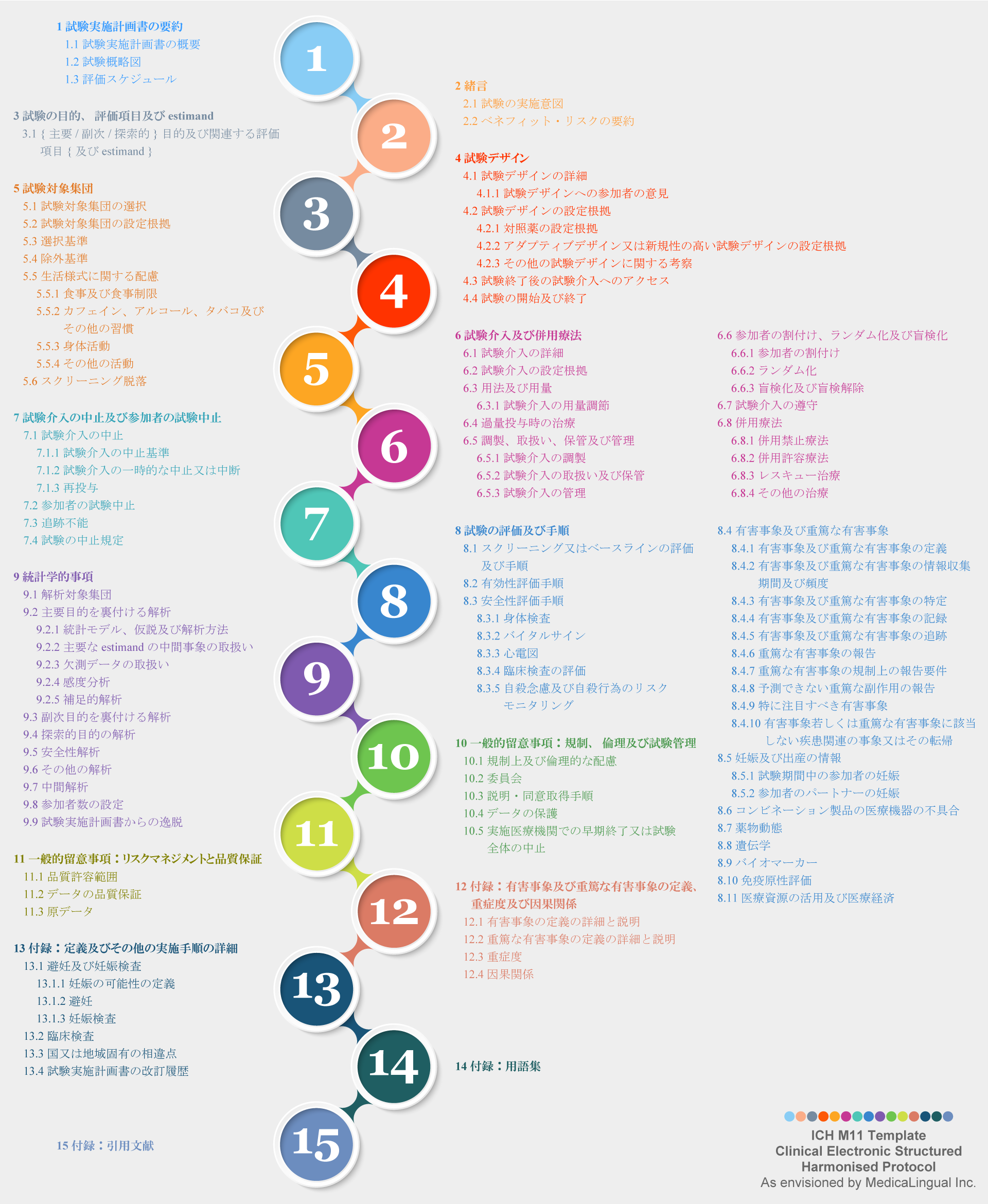
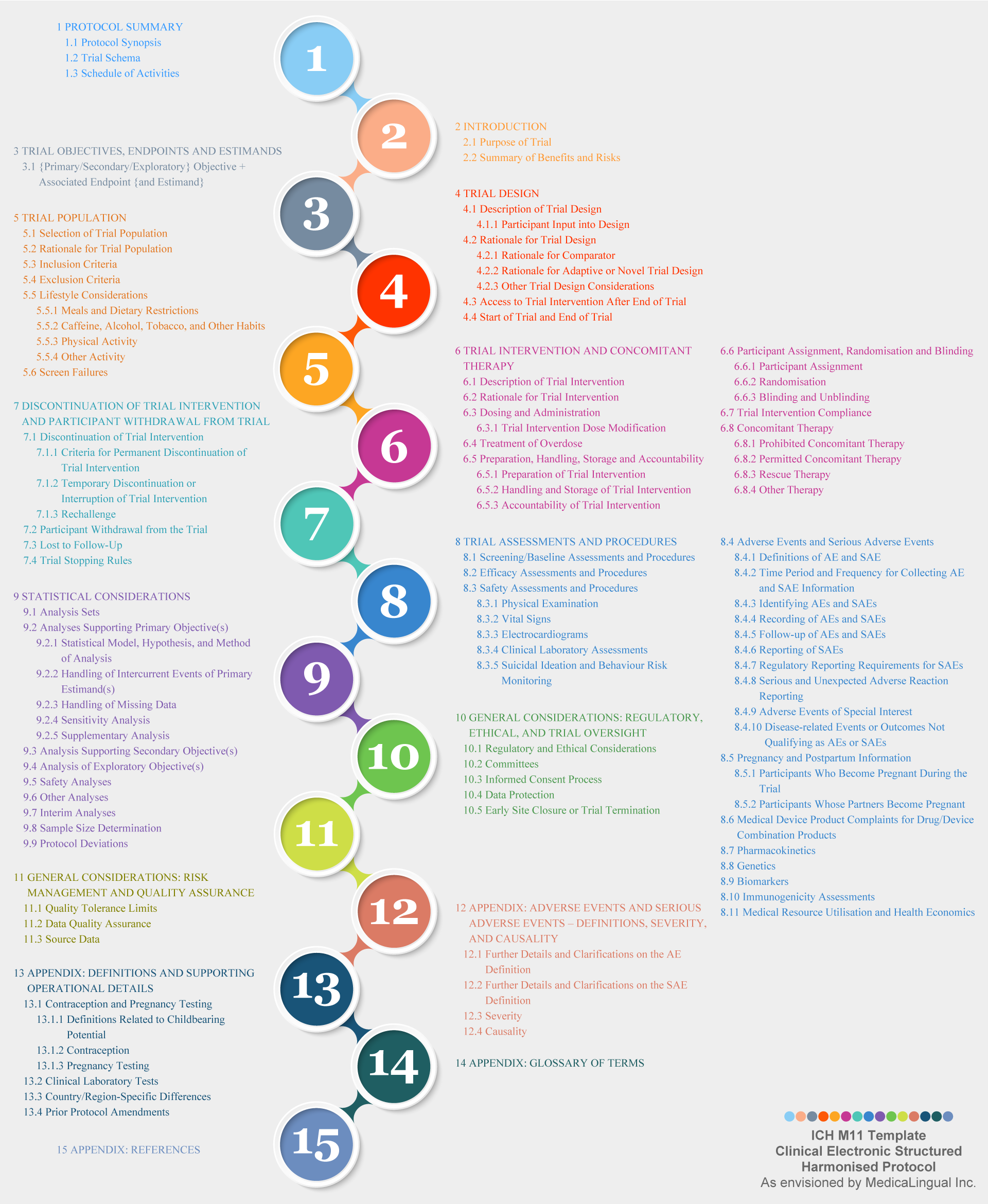
医薬品規制調和国際会議
電子的に構造化・調和された臨床試験実施計画書(CESHARP)
M11
ドラフト版
承認日:2022 年 9 月 27 日
意見募集のため公開中
ICH Harmonised Tripartite Guideline
CLINICAL ELECTRONIC STRUCTURED HARMONISED
PROTOCOL (CESHARP)
M11
Draft version
Endorsed on 27 September 2022
Currently under public consultation
At Step 2 of the ICH Process, a consensus draft text or guideline, agreed by the appropriate ICH Expert Working Group, is transmitted by the ICH Assembly to the regulatory authorities of the ICH regions for internal and external consultation, according to national or regional procedures.
臨床試験実施計画書の構成と内容
1. 緒言
1.1 背景
試験実施計画書は、ヒトを対象とした医薬品の臨床試験の実施及び解析についての方法及び手順を記述する。現在に至るまで、治験依頼者間で一貫性を保つための試験実施計画書のフォーマット及び内容、並びに試験実施計画書の情報の電子的な交換に関する国際的に用いられている調和された標準は確立されてこなかった。
治験依頼者間のフォーマットと中核となる内容のばらつきは、試験実施計画書の検索、審査及び評価における非効率性と困難さの一因となっている。試験実施計画書テンプレートの使用は、治験依頼者又は自ら治験を実施しようとする者が、完成された、曖昧さのない、よく整理された、他のICHガイドラインで示されたクオリティ・バイ・デザインの原則に沿った試験実施計画書を作成する助けとなる。試験実施計画書間で一貫性をもって、かつ同じ配置で情報を伝えることにより、試験実施計画書テンプレートは、治験依頼者、治験責任医師等、実施医療機関のスタッフ、試験の参加者、倫理委員会、規制当局等の関係者に価値を提供することを意図している。
業務要件と共通の構造化された試験実施計画書の内容を構成する要素及び電子的交換のためのオープンかつプロプライエタリ(独占的)ではない標準を示す技術仕様により、試験実施計画書の情報交換、審査及び実施を容易にする相互運用可能な電子ツールの開発が可能になる。
1.2 目的
本ガイドラインの目的は、ICH地域の全ての規制当局に受け入れられる個別の関連文書である、ICH M11 電子的に構造化・調和された臨床試験実施計画書テンプレート(以下「テンプレート」という。)及び技術仕様を作成するために用いた一般的な試験実施計画書の設計原則とアプローチを記述することである。テンプレートは、目次、共通見出し及び内容を含む試験実施計画書のフォーマットと構造を提示する。技術仕様は、試験実施計画書の内容の相互運用可能な電子的交換を可能にするコンフォーマンス(適合性)、カーディナリティ(多重度)及びその他の技術的属性を提示する。
テンプレートと技術仕様に準拠することで、試験実施計画書が規制当局に受け入れられる調和されたデータ交換のためのフォーマットで提供されることが保証される。テンプレートと技術仕様は、柔軟性を備えるように作成され、版管理される文書である。試験実施計画書の要求事項の発展及び技術の進歩に伴い、これらの文書は変更管理手順を経て改訂される可能性がある。
1.3 適用範囲
本ガイドラインに付随するテンプレート及び技術仕様文書は、利害関係者(臨床試験の立案、計画変更、審査、実施及び完了において、治験依頼者、治験責任医師等、治験審査委員会/倫理委員会及び規制当局を含む試験実施計画書の情報を使用及び交換する者)を支援することを意図したものである。テンプレート及び技術仕様は、臨床試験のあらゆる相及び治療領域における医薬品の介入を伴う臨床試験に適用可能である。介入試験には、臨床薬理試験、探索的試験、検証的試験及び製造販売後臨床試験(ICH E8 (R1) 臨床試験の一般指針を参照)が含まれるが、これらに限定されるものではない。本ガイドラインにおける「医薬品(medicinal product)」という用語及び試験実施計画書テンプレートの「試験介入(trial intervention)」という用語は、医薬品(pharmaceuticals)、生物学的製剤、ワクチン、細胞又は遺伝子治療製品(適用可能な場合)及び医薬品として取り扱われる医薬品と医療機器のコンビネーション製品を含む、あらゆる治療薬、予防薬又は診断薬を指す。
本ガイドライン、テンプレート及び技術仕様は、試験実施計画書の作成及び維持管理に関連するプロセスを規定することを意図したものではない。これらは、試験実施計画書の内容に関する要求事項を定めた他のガイドラインを代替又は否定するものではない。これらは、適切にデザインされた臨床試験の立案についての指示を提供することや適切に作成された完成版の試験実施計画書を特徴づけるものではない。むしろ、ICH M11ガイドライン、テンプレート及び技術仕様は、他の広く使用されているガイドラインで示された内容の配置に関する共通の指示だけではなく、その内容の相互運用可能な電子的交換を可能にする技術的属性も確立する。
STRUCTURE AND CONTENT OF A CLINICAL PROTOCOL
1. INTRODUCTION
1.1 Background
The clinical protocol describes the processes and procedures directing the conduct and analysis of a clinical trial of medicinal product(s) in humans. To date, no internationally adopted harmonised standard has been established for the format and content of the clinical protocol to support consistency across sponsors and for the electronic exchange of protocol information.
Variability in format and core content among sponsors contributes to inefficiencies and difficulties in searching, reviewing, and assessing clinical trial protocols. Use of the clinical trial protocol template aids the sponsor or sponsor-investigator in the development of a protocol that is complete, free from ambiguity, well organised, and aligned with quality by design principles as set forth in other ICH guidelines. By conveying information consistently and in the same location across clinical trial protocols, a protocol template is intended to provide value to parties that include sponsors, investigators, clinical site personnel, trial participants, ethics committees, and regulators.
A technical specification presenting the business requirements and common structured protocol content components and an open, non-proprietary standard for electronic exchange enables development of interoperable electronic tools to facilitate exchange, review, and execution of protocols.
1.2 Purpose
The purpose of this guideline is to describe the general protocol design principles and approach used to develop the separate associated documents, the ICH M11 Clinical Electronic Structured Harmonised Protocol Template [Template] and the Technical Specification that are acceptable to all regulatory authorities of the ICH regions. The Template presents the format and structure of the protocol, including the table of contents, common headers, and contents. The Technical Specification presents the conformance, cardinality, and other technical attributes that enable the interoperable electronic exchange of protocol content.
Conformance with this Template and Technical Specification should ensure that protocols are provided in a harmonised data exchange format acceptable to the regulatory authorities. The Template and Technical Specification have been developed with built-in flexibility and are versioned documents. As clinical protocol requirements evolve and technology advances, they may be revised subject to a change control process.
1.3 Scope
The Template and Technical Specification documents supported by this guideline are intended to assist stakeholders (those who use and exchange protocol information, including sponsors, investigators, institutional review boards / ethics committees and regulators in the development, amendment, review, conduct, and closeout of a clinical trial). The Template and Technical Specification are applicable to interventional clinical trials of medicinal products across all phases and therapeutic areas of clinical research. Interventional trials may include but are not limited to human pharmacology, exploratory, confirmatory, and post-approval studies (see ICH E8(R1) General Considerations for Clinical Studies). The term “medicinal product” in this guideline, and the term “trial intervention” in the protocol Template refer to any therapeutic, prophylactic, or diagnostic agent including pharmaceuticals, biologics, vaccines, cell or gene therapy products (when applicable), as well as drug-device combination products when registered as a drug.
Neither this Guideline nor the Template or Technical Specification are intended to specify processes related to development and maintenance of a protocol. They do not supersede or negate other guidelines that establish requirements for protocol content. They neither provide instruction on either the development of a well-designed trial nor do they characterise a well-crafted final protocol. Rather, the ICH M11 Guideline, Template, and Technical Specification establish common instructions for placement of content, as reflected in other prevailing guidelines, as well as the technical attributes for interoperable electronic exchange of that content.
2. 一般的な設計原則
2.1 電子的に構造化・調和された臨床試験実施計画書-テンプレート
テンプレートは、臨床試験の立案、計画変更、審査、実施及び完了、並びに試験実施計画書の情報の交換における一貫性と効率性を促進するために、調和された標準的な試験実施計画書を支持する一般原則に基づいて設計された。具体的には、以下の原則が含まれる。
- 共通の中核となる内容を構築する-テンプレートの設計は、医薬品の臨床試験のための中核となる一連の情報を示す。
- 利害関係者のニーズに応える-テンプレートの構造と内容は、利害関係者が、統一された目次、共通の項目見出し、内容及び共通の用語を一貫して曖昧さなく含む試験実施計画書を作成、審査及び使用するための枠組みを提供する。
- 電子的交換の内容を定義する-試験実施計画書の内容は、現在(例えば、電子化コモン・テクニカル・ドキュメント)及びその他の将来の技術を使用して、治験依頼者や規制当局を含む当事者間で電子的に交換できるようになる。
- 内容の再利用を意図する-試験実施計画書は、臨床試験の管理及び審査プロセスの一部として再利用できる豊富な情報源であり、例えば、臨床試験の透明性を促進するために臨床試験登録での公開及び標準化された臨床試験データの取得に使用することができる。
- 柔軟性を維持する-テンプレートには、柔軟性を維持するための推奨及び任意のテキストとデータフィールドの両方が組み込まれている。上位の見出し構造は変更不可である一方、下位の項目は必要に応じて追加、削除又は変更が可能となっている。
テンプレートは、臨床試験の実施に関連する他のICHガイドラインとともに使用されるべきである。
2.2 電子的に構造化・調和された臨床試験実施計画書-技術仕様
技術仕様は、構造化された内容の構成要素(例えば、特定のデータフィールドやテキストベースの内容のブロック)の詳細な記述とともに、テンプレートで確立されたその他の定義属性や記載ルールを含む。
技術仕様は以下の設計原則に基づいている。
- 構造化された共通の中核となる内容を推進する
- 電子的交換の内容の仕様を定義する
- 仕様に基づいたデータモデルを作成する
- 関連する内容の利用と再利用に焦点を当てる
- オープンかつプロプライエタリ(独占的)ではないメッセージ交換の標準を使用する
- 技術イノベーションと地域固有の使用に対する柔軟性を維持する
2. GENERAL DESIGN PRINCIPLES
2.1 Clinical Electronic Structured Harmonised Protocol – Template
The Template was designed based on general principles that would support a harmonised standard protocol to facilitate consistency and efficiency in the development, amendment, review, conduct and closeout of a clinical trial and the exchange of protocol information. Specifically, the principles include:
- Build common core content – The Template design represents a core set of information for a clinical trial of any medicinal product(s).
- Serve the needs of stakeholders – The Template’s structure and content provide a framework for relevant stakeholders to develop, review and use protocols that consistently and unambiguously include a uniform table of contents, common section headers and content, as well as common
- Define content for electronic exchange – The protocol content can be electronically exchanged among parties, including sponsors and regulators, using current (for example, electronic common technical document) and other future
- Design for content re-use – The clinical protocol is a rich source of information that can be re-used as part of the clinical trial management and review process, and, for example, published on clinical trial registries to promote clinical trial transparency and used in standardised clinical trial data
- Maintain flexibility – The Template incorporates both recommended and optional text and data fields to maintain Higher-level heading structure is conserved, while lower level sections can be added, removed, or modified as needed.
The Template should be used in conjunction with other ICH Guidelines relevant to the conduct of clinical trials.
2.2 Clinical Electronic Structured Harmonised Protocol – Technical Specification
The Technical Specification includes detailed descriptions of the structured content components (for example, specific data fields and blocks of text-based content), along with other defining attributes and business rules as established in the Template.
The Technical Specification is based on the following design principles:
- Promote structured common core content
- Define content specifications for electronic exchange
- Develop a data model based on specifications
- Focus on relevant content use and re-use
- Use an open, non-proprietary exchange message standard
- Maintain flexibility for technical innovation and region-specific use
3. テンプレートの規約と設計
テンプレートは、治験責任医師等や実施医療機関のスタッフ、規制当局の審査担当者、治験依頼者の担当者等、多様な利用者のニーズを満たす完成版の試験実施計画書を明確に実現できるものでなければならない。効率的かつ正確な臨床試験の実施を容易にするために、治験責任医師等や実施医療機関のスタッフのニーズに対して最大の配慮がなされた。以下の点に従っている。
- テンプレートは、臨床試験の実施に最も重要な情報(例えば、概要、概略図、評価スケジュール)を冒頭に配置して設計されている。
- テンプレートは本文・付録の枠組みで構成されており、臨床試験固有の情報は本文にあり、参照すべき情報の詳細及びより一般的な(臨床試験固有ではない)情報は付録にある。この構成は、臨床試験の実施上の有用性のためだけに採用された。
- 付録に含まれる内容は、本文の内容と同等の重みと厳密さを有している。
- 不要な繰返しは可能な限り排除している。
3. TEMPLATE CONVENTIONS AND DESIGN
The Template must obviously enable a final protocol that meets the needs of its diverse audience, which include investigators, and site staff, regulatory reviewers, and sponsor personnel. To facilitate efficient and accurate execution, chief consideration was given to the needs of investigators and site staff. Accordingly:
- The Template is designed with the most vital information for execution (for example, Synopsis, Schema, Schedule of Activities) near the
- The Template is organised in a Main Body/Appendix framework, in which trial-specific information is in the Main Body, while reference details and more general (non-trial- specific) information is in the This organisational construct was adopted merely for its utility during execution.
- Content in the Appendix carries equal weight and rigor as the content in the Main
- Unnecessary repetition is eliminated wherever





